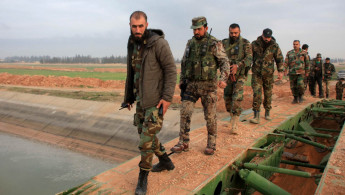Leading Syrian regime generals gathered to watch a chemical attack on an Idlib hospital
The investigation published on Wednesday pieced together footage from the regime's official news channel with the findings from last week’s OPCW report that had identified Bashar al-Assad's regime as the perpetrators of the chemical attack on the hospital on 25th March 2017.
Regime media reported at the time that a delegation of generals visited a command post in the Hama region and observed strikes on the nearby town of Latamenah that day.
Syria Weekly: Assad regime finally acknowledged as chemical attacks culprit
The delegation included both then Syrian army Chief of Staff, General Ali Abdullah Ayoub, as well as Brigadier Suheil Al-Hassan, the commander of the so-called "Tiger Forces", who have been linked with chlorine attacks using helicopters.
Twitter Post
|
Using advanced imaging techniques analysing shadows and watch faces, Bellingcat suggested that the generals were likely at the post 30 minutes before helicopters loaded with chlorine munitions left Hama air base to attack Latamenah’s hospital.
The findings may prove valuable in further establishing responsibility for the horrific chemical attacks during the Syrian war.
Comment: For Syrian chemical attack victims, OPCW report blaming Assad is too little, too late
The OPCW report published on 8 April marked the first time in history that the organisation named the perpetrators of chlorine and sarin attacks in Syria.
"At approximately 15:00 on 25 March 2017, a helicopter of the Syrian Arab Air Force, departing from Hama airbase, dropped a cylinder on the Ltamenah hospital; the cylinder broke into the hospital through its roof, ruptured, and released chlorine, affecting at least 30 persons," the OPCW said in a press release.
The report also concluded that the Syrian regime was responsible for two other chemical attacks the same month that used the deadly nerve agent sarin.
Follow us on Facebook, Twitter and Instagram to stay connected





 Follow the Middle East's top stories in English at The New Arab on Google News
Follow the Middle East's top stories in English at The New Arab on Google News


